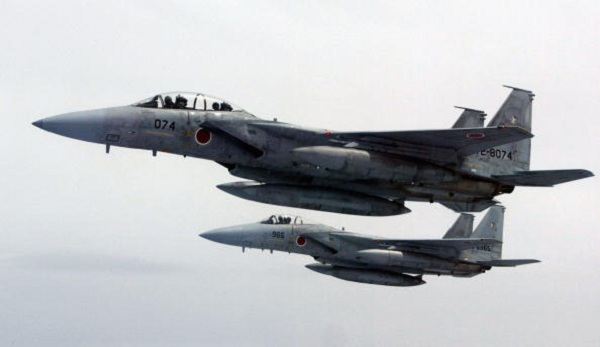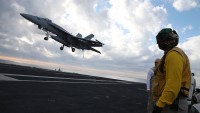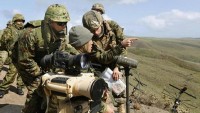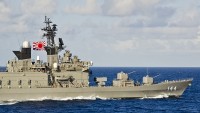Japan Forms New Air Wing, Unveils New Stealth Fighter to Fend Off China
| Carlos Castillo | | Feb 02, 2016 06:04 AM EST |
(Photo : Getty Images/Koichi Kamoshida) Two Japanese F-15 aircraft fly in formation over the East China Sea. The Japanese government is creating a new fighter air wing to strengthen Japan Air Self-Defense Force (JASDF).
The Japanese government announced on Sunday the formation of a new fighter air wing to strengthen Japan Air Self-Defense Force (JASDF) amid increasing tensions with China over the Senkaku Islands in the East China Sea.
The country's Parliamentary Vice-Minister of Defense Kenji Wakamiya made the announcement during a ceremony at the Naha Airbase on Okinawa Island, from where Japan's new ninth Air Wing will operate.
Like Us on Facebook
The Naha Airbase is on the southern tip of the Nansei island chain, around 420 kilometers east of the disputed Senkaku island group, which China also claims.
"This is a very frontline of national defense," Wakamiya said in a speech.
Shift South
Tensions have been rising steadily in the East China Sea in recent years, with Japanese and Chinese fighter aircraft frequently coming into contact over the contested islands.
Tempers nearly reached a boiling point in September 2012 when the Japanese -- who have been the island's administrators since 1895 -- purchased three islands from a private owner in an effort to bring the islands more closely under their control.
China has since stepped up its claims over the area, and has on several occasions sent armed vessels and fighter aircraft into what Japan sees as its territory and airspace. The UK Telegraph reports that the Chinese incursions are intended to test Japan's response.
The Japanese defense ministry claims to have scrambled fighters from its Naha Airbase some 441 times last year, mostly to ward off Chinese People's Liberation Army Air Force (PLAAF) aircraft. Japan has subsequently doubled the number of its combat aircraft at the Naha Airbase, increasing the size of the 9th Air Wing to some 40 Japanese F-15 jet fighters.
Experts say the creation of the new air wing forms part of a fundamental shift south for Japan's air defense posture, a move that Tokyo wants to bolster with new combat aircraft.
"Shifting ASDF assets to the southwest is a good thing, not least it potentially takes some of the pressure off ASDF aircraft that are so busy responding to Chinese incursions that they have reduced training time along with the sheer wear and tear that comes of constantly responding to PRC aircraft," Grant Newsham, a senior research fellow at the Japan Forum of Strategic Studies, told Defense News.
Mitsubishi X2
The Japanese defense ministry plans to purchase 42 F-35 stealth fighters this year even as it has hinted at the possibility of replacing at least some of its aging F-15s with a permutation of Japan's newly-unveiled stealth fighter, the Mitsubishi Heavy Industries (MHI) X2.
Japanese officials have been tight-lipped about the features of the X2 which -- according to some reports -- is specifically intended as a design progenitor to the F-3, the fighter Japan will roll out to counter the new generation of Chinese combat aircraft.
Citing expert analysts, however, the Wall Street Journal suggests that rather than building a new plane, Japan may choose to join the US or other allies in developing a sixth generation fighter through international partnership.
"In order to participate in a project as an equal partner, Japan has to offer knowledge, experience or technologies worthy of an equal partner," aerospace analyst Yoshitomo Aoki told the Journal.
Aerospace experts present during the X2's unveiling at the MHI factory in Toyoyama, central Japan, last week say the plane is small -- about 46-feet long with a 29-foot wingspan. The twin engine design, which uses two Ishikawa Heavy Industries low-bypass turbofan engines, is said to be capable of delivering a total 10 tons of thrust.
The X2 is reportedly equipped with state-of-the-art Self Repairing Flight Control Capability (SRFCC) technology, which allows the aircraft to automatically detect damage in its flight control surfaces. The system then calibrates the remaining control surfaces to retain controlled flight.
Japan is said to have spent some $340 million to develop the X2, which is scheduled to take to the air for the first time later this month.
TagsChina-Japan Dispute, Diaoyu Islands (Senakaku Islands), East China Sea dispute
©2015 Chinatopix All rights reserved. Do not reproduce without permission
EDITOR'S PICKS
-

Did the Trump administration just announce plans for a trade war with ‘hostile’ China and Russia?
-

US Senate passes Taiwan travel bill slammed by China
-

As Yan Sihong’s family grieves, here are other Chinese students who went missing abroad. Some have never been found
-

Beijing blasts Western critics who ‘smear China’ with the term sharp power
-

China Envoy Seeks to Defuse Tensions With U.S. as a Trade War Brews
-

Singapore's Deputy PM Provides Bitcoin Vote of Confidence Amid China's Blanket Bans
-

China warns investors over risks in overseas virtual currency trading
-

Chinese government most trustworthy: survey
-

Kashima Antlers On Course For Back-To-Back Titles
MOST POPULAR
LATEST NEWS
Zhou Yongkang: China's Former Security Chief Sentenced to Life in Prison

China's former Chief of the Ministry of Public Security, Zhou Yongkang, has been given a life sentence after he was found guilty of abusing his office, bribery and deliberately ... Full Article
TRENDING STORY

China Pork Prices Expected to Stabilize As The Supplies Recover

Elephone P9000 Smartphone is now on Sale on Amazon India

There's a Big Chance Cliffhangers Won't Still Be Resolved When Grey's Anatomy Season 13 Returns

Supreme Court Ruled on Samsung vs Apple Dispute for Patent Infringement

Microsoft Surface Pro 5 Rumors and Release Date: What is the Latest?













